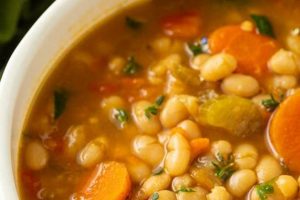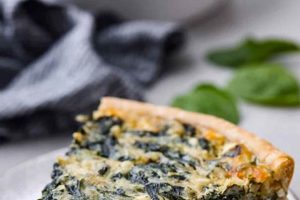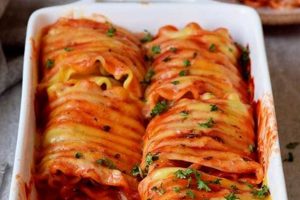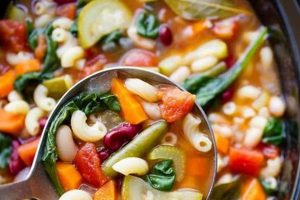A method for preparing flatbreads without the use of animal-derived ingredients is defined as a plant-based flatbread formulation. This process typically involves combining flour, water, oil, and salt to create a dough, which is then pressed and cooked to produce a pliable flatbread suitable for various culinary applications. An example is the utilization of whole wheat flour, olive oil, and water to produce a hearty flatbread suitable for wraps or tacos.
The significance of this method lies in its alignment with dietary preferences that exclude animal products, offering a versatile and customizable alternative to traditional flatbreads. This approach provides nutritional benefits by allowing for the incorporation of whole grains and healthier fats, contributing to a balanced diet. Historically, variations of this practice have existed in cultures where plant-based diets are prevalent, reflecting regional ingredient availability and culinary traditions.
The following sections will explore various aspects of this method, including ingredient selection, preparation techniques, cooking methods, and potential modifications for specific dietary needs or flavor profiles. Further examination will also cover storage recommendations and considerations for achieving optimal texture and taste in the finished product.
Production Optimization Guidelines
The subsequent recommendations are designed to refine the flatbread production process, emphasizing techniques to improve the final product’s texture, flavor, and structural integrity.
Tip 1: Flour Selection Impacts Texture. Employing different flours, such as bread flour or a combination of all-purpose and whole wheat, will demonstrably affect the elasticity and chewiness of the dough. Bread flour, with its higher gluten content, will yield a more pliable and resilient flatbread.
Tip 2: Water Temperature Controls Gluten Development. Using warm water, typically between 100-110F (38-43C), encourages optimal gluten development, leading to a softer and more cohesive dough. Avoid excessively hot water, which can denature the gluten proteins.
Tip 3: Rest Period Enhances Dough Relaxation. Allowing the dough to rest for at least 30 minutes, or preferably an hour, permits the gluten strands to relax. This relaxation results in a more easily rolled and less prone-to-shrinking flatbread.
Tip 4: Thin Rolling Promotes Even Cooking. Ensure uniform thinness when rolling the dough to facilitate even cooking and prevent localized burning. A consistent thickness also contributes to a more tender final product.
Tip 5: Hot Pan Facilitates Puffing. A preheated, dry pan is crucial for achieving optimal puffing during cooking. This puffing creates desirable air pockets within the flatbread, contributing to a lighter texture.
Tip 6: Controlled Cooking Time Prevents Hardening. Overcooking results in a dry and brittle flatbread. Monitor the cooking time closely and remove the flatbread from the heat as soon as it exhibits golden-brown spots and slight puffing.
Tip 7: Immediate Covering Preserves Softness. After cooking, covering the flatbreads with a clean kitchen towel helps trap moisture, preventing them from drying out and maintaining their pliability.
Adherence to these guidelines will contribute to a superior outcome, characterized by enhanced texture, improved flavor, and increased structural integrity. This refined process ensures a final product suitable for a wide range of culinary applications.
The following section presents potential ingredient variations and substitutions designed to tailor the flatbread formulation to specific dietary requirements and preferences.
1. Flour Type
The selection of flour is a critical determinant in the texture, flavor, and overall success of any flatbread preparation, including those adhering to plant-based formulations. The flour’s composition dictates the gluten development, which subsequently impacts the elasticity and tenderness of the final product.
- Gluten Content and Development
Different flour types possess varying levels of gluten-forming proteins, gliadin and glutenin. Higher protein content, as found in bread flour, results in a more elastic and chewy texture, desirable for certain flatbread styles. Lower protein content, as in pastry flour, produces a more tender and crumbly result, less suitable for traditional flatbreads that require pliability. Whole wheat flour, while adding nutritional value, can inhibit gluten development due to the presence of bran, potentially leading to a denser and less elastic product. Appropriate adjustments to hydration and kneading techniques may be necessary to compensate.
- Whole Wheat Flour Considerations
The use of whole wheat flour introduces nutritional benefits, including increased fiber content, but presents challenges in achieving a pliable texture. The bran present in whole wheat flour interferes with gluten formation, potentially resulting in a coarser and less elastic flatbread. To mitigate this effect, strategies such as pre-soaking the flour or combining it with a higher-gluten white flour can be employed.
- Gluten-Free Flour Alternatives
For individuals with gluten sensitivities or celiac disease, gluten-free flour blends offer a viable alternative. These blends typically consist of a combination of flours, such as rice flour, tapioca starch, and potato starch, along with a binding agent like xanthan gum to mimic the elastic properties of gluten. The selection of specific gluten-free flour blends influences the final product’s texture and requires careful consideration of hydration and cooking techniques.
- Flavor Profiles of Different Flours
Beyond texture, the type of flour contributes to the overall flavor profile of the flatbread. All-purpose flour provides a neutral base, allowing other ingredients to shine. Whole wheat flour imparts a nutty and slightly earthy flavor, while flours like rye or spelt can introduce more complex and distinctive tastes. The choice of flour allows for customization of the flavor profile to complement various fillings and toppings.
The selection of flour for plant-based flatbread preparation involves a careful balance between desired texture, nutritional considerations, and flavor preferences. Understanding the properties of different flour types and their impact on gluten development is crucial for achieving a successful and palatable final product. By manipulating flour blends and adjusting preparation techniques, the characteristics of the flatbread can be tailored to suit a wide range of culinary applications.
2. Hydration Level
Hydration level, the ratio of liquid to flour in a dough, exerts a significant influence on the texture, pliability, and overall quality of plant-based flatbreads. Precise control over hydration is essential for achieving the desired consistency and preventing issues such as excessive stickiness or dryness.
- Impact on Gluten Development
Water activates gluten-forming proteins in flour, initiating the development of a network responsible for dough elasticity and structure. Insufficient hydration hinders gluten development, resulting in a crumbly and difficult-to-roll dough. Conversely, excessive hydration leads to a sticky dough that is challenging to manage and prone to tearing. The optimal hydration level facilitates sufficient gluten development without compromising workability.
- Influence on Dough Pliability
Dough pliability directly correlates with the ease of rolling and shaping plant-based flatbreads. A properly hydrated dough exhibits a smooth and elastic texture, allowing for thin rolling without tearing or cracking. Under-hydrated dough tends to be stiff and resistant to rolling, while over-hydrated dough adheres excessively to surfaces and is difficult to manipulate. Adjustments to hydration ensure a pliable dough that can be easily formed into thin, uniform flatbreads.
- Effect on Final Product Texture
The hydration level profoundly affects the final texture of the cooked flatbread. Insufficient hydration yields a dry, brittle, and often tough flatbread. Over-hydration, on the other hand, can result in a gummy or soggy texture. The ideal hydration level produces a tender, pliable flatbread with a slight chew, suitable for wrapping or folding.
- Considerations for Different Flour Types
Different flour types exhibit varying levels of water absorption. Whole wheat flour, due to its higher fiber content, typically requires more hydration than all-purpose flour. Gluten-free flour blends often necessitate even greater hydration and the inclusion of binding agents like xanthan gum to compensate for the lack of gluten. Adjusting the hydration level based on the specific flour blend is crucial for achieving optimal dough consistency and final product quality.
Achieving the correct hydration level in plant-based flatbread preparation is a nuanced process requiring careful attention to flour type and desired texture. By understanding the impact of hydration on gluten development, dough pliability, and final product characteristics, one can consistently produce flatbreads that are tender, pliable, and well-suited for various culinary applications. Adjustments to hydration levels can be crucial to adapt a flatbread recipe to the various types of flour.
3. Fat source
The inclusion of a fat source is a significant factor in determining the texture, flavor, and handling properties of plant-based flatbreads. The fat interacts with the flour and water during dough formation, impacting gluten development and the final product’s pliability. Examples of suitable fat sources include vegetable oils (such as olive, canola, or avocado oil), plant-based butter alternatives, or even nut butters in certain specialized recipes. The presence of fat inhibits excessive gluten development, resulting in a more tender product, and it also contributes to a richer flavor profile. Without an appropriate fat source, the flatbread tends to be tougher, drier, and more prone to tearing.
The specific type of fat utilized influences the outcome. Oils with neutral flavors, such as canola, provide a subtle effect, while olive oil imparts a distinct flavor. Plant-based butter alternatives contribute a buttery taste and can enhance browning during cooking. Nut butters, used sparingly, can introduce unique flavors and textures. Furthermore, the quantity of fat is crucial. Too little fat results in a tough product, while excessive fat can lead to a greasy or difficult-to-handle dough. Accurate measurement and distribution of the fat source are essential for a successful outcome. For example, a whole wheat flatbread often benefits from a higher proportion of fat to counteract the drying effect of the bran.
In summary, the selection and incorporation of a fat source are integral to producing high-quality, plant-based flatbreads. Understanding the effects of different fats on gluten development, texture, and flavor allows for customization and optimization of the recipe. Challenges may include finding the right balance for specific flour types or dietary requirements, but careful experimentation leads to predictable results. The deliberate consideration of the fat source is a fundamental aspect of plant-based flatbread preparation.
4. Kneading Time
Kneading time constitutes a crucial variable in the preparation of plant-based flatbreads. Its precise duration directly influences gluten development, dough texture, and ultimately, the final product’s characteristics.
- Gluten Network Development
Kneading is the mechanical process that aligns and strengthens gluten strands within the dough. This alignment creates a network that provides elasticity and structure. Insufficient kneading results in a weak gluten network, leading to a flatbread that lacks pliability and tears easily. Conversely, excessive kneading can overdevelop the gluten, producing a tough and rubbery texture. Optimizing kneading time ensures a balanced gluten structure, providing the desired chewiness and extensibility for plant-based flatbreads.
- Dough Consistency and Workability
The consistency of the dough is directly related to kneading time. A properly kneaded dough will be smooth, elastic, and slightly tacky, allowing for easy rolling and shaping. Under-kneaded dough will be shaggy, rough, and difficult to work with, while over-kneaded dough may become stiff and lose its ability to stretch without snapping back. Therefore, an appropriate kneading time is essential for achieving a dough that is manageable and conducive to producing thin, uniform flatbreads.
- Impact on Texture
The kneading time has a measurable effect on the final texture of the flatbread. If the gluten in the dough is weak, then the tortilla won’t be able to handle fillings or hold its shape correctly. This process ensures that the final flatbread is soft, slightly chewy, and able to withstand folding or filling without cracking.
- Considerations for Plant-Based Variations
Plant-based flatbreads, especially those incorporating whole wheat flour or gluten-free alternatives, may require adjustments to kneading time. Whole wheat flour can hinder gluten development, potentially necessitating longer kneading. Gluten-free flour blends, lacking gluten, do not benefit from extensive kneading and may become tough. In these cases, shorter kneading times or alternative mixing techniques may be more appropriate to achieve the desired texture. Careful observation of the dough’s consistency is essential when adapting kneading times for plant-based variations.
In conclusion, the careful management of kneading time is fundamental to the successful execution of a plant-based flatbread formulation. By understanding its influence on gluten development, dough consistency, and final product texture, it is possible to produce flatbreads that are both structurally sound and palatable. Modifying kneading times to account for plant-based ingredients promotes optimal results.
5. Resting period
The resting period is an integral stage in the plant-based flatbread preparation process, significantly impacting the dough’s extensibility and final product texture. This phase allows for gluten relaxation and hydration of the flour, contributing to a more pliable and manageable dough.
- Gluten Relaxation and Dough Extensibility
Following kneading, the gluten strands are tightly wound and resistant to stretching. The resting period facilitates gluten relaxation, allowing the strands to unwind and become more extensible. This increased extensibility results in a dough that is easier to roll out into thin, uniform circles without tearing or snapping back. Inadequate resting can lead to difficulties in achieving the desired thinness and shape of the flatbread.
- Flour Hydration and Dough Softness
During resting, the flour particles fully absorb the water, leading to a softer and more cohesive dough. This complete hydration reduces the risk of a dry or crumbly final product. The resting period allows the moisture to distribute evenly throughout the dough, ensuring consistent texture and pliability. If the flour is not fully hydrated, the flatbread may be prone to cracking or becoming too stiff after cooking.
- Enzyme Activity and Flavor Development
Resting provides an opportunity for natural enzymes present in the flour to break down complex carbohydrates into simpler sugars. This enzymatic activity contributes to a subtle but noticeable enhancement of the flatbread’s flavor. While not as pronounced as in long-fermented breads, this process adds depth and complexity to the overall taste profile.
- Time Optimization and Practical Considerations
The optimal resting time varies depending on the flour type, hydration level, and environmental factors such as temperature and humidity. A minimum of 30 minutes is typically recommended, but longer resting periods (up to several hours) can further improve dough extensibility. In practical terms, the resting period allows for flexibility in the flatbread-making process, enabling the dough to be prepared in advance and cooked later. This can be particularly useful for meal planning and batch cooking.
In conclusion, the resting period is a critical step in plant-based flatbread preparation, influencing gluten relaxation, flour hydration, flavor development, and overall dough manageability. Proper implementation of this stage contributes significantly to the quality and ease of production of plant-based flatbreads. Neglecting this step will often lead to a less desirable outcome.
6. Cooking Temperature
Cooking temperature is a critical factor in achieving optimal texture, pliability, and browning in plant-based flatbreads. Precise temperature control ensures the flatbread cooks evenly and develops the desired characteristics without becoming overly dry or burnt.
- Impact on Moisture Content
High cooking temperatures lead to rapid evaporation of moisture from the dough, potentially resulting in a dry and brittle flatbread. Conversely, low temperatures may result in a soggy or undercooked product. The ideal cooking temperature balances the rate of moisture evaporation with the rate of starch gelatinization and protein coagulation, resulting in a pliable and tender flatbread. For example, cooking on a dry skillet at medium-high heat (approximately 400-450F or 200-230C) typically yields the best results. Monitoring the flatbread closely and adjusting the heat as needed is crucial to preventing excessive drying or burning.
- Role in Maillard Reaction
The Maillard reaction, a chemical reaction between amino acids and reducing sugars, is responsible for the desirable browning and flavor development in flatbreads. This reaction occurs more readily at higher temperatures. Insufficient heat may result in a pale and flavorless flatbread, while excessive heat can lead to burnt or bitter flavors. Achieving an even, golden-brown color indicates that the Maillard reaction has proceeded optimally, contributing to a more appealing and flavorful product. The presence of sugars, whether naturally occurring in the flour or added as an ingredient, influences the rate and extent of the Maillard reaction.
- Influence on Dough Puffing
The rapid expansion of steam within the dough creates air pockets that contribute to the flatbread’s light and airy texture. Adequate cooking temperature is necessary to generate sufficient steam pressure for this puffing to occur. A preheated cooking surface is crucial for achieving optimal puffing. The absence of sufficient heat may prevent the dough from puffing, resulting in a dense and flat product. Conversely, excessively high heat can cause the flatbread to burn before it has a chance to fully puff.
- Effect of Cooking Surface Material
The material of the cooking surface influences heat distribution and cooking speed. Cast iron skillets, for example, retain heat well and provide even cooking, while thinner surfaces may heat up and cool down more quickly. Adjustments to the cooking temperature may be necessary depending on the material of the cooking surface. Monitoring the flatbread closely and adjusting the heat as needed is essential to prevent uneven cooking or burning. Furthermore, ensuring the cooking surface is clean and free of debris prevents sticking and promotes even browning.
The precise control of cooking temperature is paramount in the successful execution of a plant-based flatbread. Balancing the need for moisture evaporation, Maillard reaction, and dough puffing ensures a product that is both visually appealing and texturally satisfying. Consideration of the cooking surface material further refines the process, allowing for adjustments that optimize the final outcome and create an evenly cooked, well-browned, and pliable flatbread.
7. Shelf life
The duration for which a plant-based flatbread remains palatable and safe for consumption, termed shelf life, is significantly influenced by several factors inherent in its formulation and storage. The absence of animal-derived ingredients necessitates a focus on preventing microbial spoilage and maintaining acceptable sensory attributes over time. Lipid oxidation, starch retrogradation, and moisture migration represent key degradation pathways affecting product quality. For example, a flatbread prepared with high-moisture content and unsaturated oils will exhibit a shorter shelf life due to increased susceptibility to microbial growth and rancidity, respectively. Understanding these mechanisms is crucial for optimizing preservation strategies.
Strategies to extend the shelf life of plant-based flatbreads typically involve manipulating formulation and employing appropriate packaging techniques. The incorporation of natural preservatives such as vinegar or lactic acid can inhibit microbial growth. Modified atmosphere packaging (MAP), where the air within the package is replaced with a gas mixture designed to inhibit spoilage organisms, represents another effective approach. Furthermore, controlling water activity (aw) through ingredient selection and processing parameters is essential. Lowering the aw value reduces the availability of water for microbial growth and slows down enzymatic reactions that contribute to degradation. For instance, a flatbread stored in a hermetically sealed package with a low oxygen environment will retain its freshness for a prolonged period compared to one exposed to atmospheric conditions.
In summary, achieving an acceptable shelf life for plant-based flatbreads requires a multi-faceted approach encompassing careful ingredient selection, process optimization, and appropriate packaging. While the absence of animal products eliminates certain spoilage concerns, other degradation pathways necessitate proactive mitigation strategies. Understanding the interplay between formulation, storage conditions, and degradation mechanisms is essential for producing a commercially viable and consumer-acceptable product. The ability to extend shelf life directly translates to reduced food waste, enhanced distribution capabilities, and improved economic sustainability.
Frequently Asked Questions
The subsequent inquiries address common misconceptions and concerns regarding the preparation and properties of flatbreads adhering to plant-based dietary guidelines. The information provided aims to clarify best practices and optimize outcomes.
Question 1: Does the absence of traditional binding agents, such as eggs, compromise structural integrity?
No. Gluten development, achieved through appropriate kneading and resting, provides sufficient structural support. Additionally, ingredients such as psyllium husk or flaxseed meal can augment binding properties in gluten-free variations.
Question 2: How does the texture of a plant-based flatbread compare to its conventional counterpart?
Texture is primarily influenced by flour selection, hydration levels, and cooking technique. With proper execution, a plant-based flatbread can achieve comparable tenderness and pliability to those incorporating animal products.
Question 3: What are the optimal storage methods for maintaining freshness and preventing spoilage?
Storing flatbreads in airtight containers or resealable bags at room temperature is recommended. Refrigeration can extend shelf life but may also lead to drying. Freezing is a viable option for long-term storage; however, thawing should be gradual to minimize moisture loss.
Question 4: Can plant-based flatbreads be adapted for individuals with gluten sensitivities or celiac disease?
Yes. Gluten-free flour blends, incorporating ingredients such as rice flour, tapioca starch, and potato starch, provide suitable alternatives. However, the absence of gluten necessitates the inclusion of binding agents like xanthan gum or guar gum to mimic its elastic properties.
Question 5: Does the use of plant-based oils significantly alter the flavor profile?
The type of oil selected can subtly influence flavor. Neutral oils, such as canola or sunflower, have minimal impact. Olive oil imparts a distinct flavor, while coconut oil can add a subtle sweetness. The choice of oil should align with the desired taste profile of the final product.
Question 6: Are there any nutritional considerations specific to plant-based flatbreads?
Plant-based formulations often allow for the incorporation of whole grains and healthier fats. However, it is essential to ensure adequate nutrient intake by supplementing with other food sources, particularly iron and vitamin B12, which are commonly found in animal products.
The information presented clarifies common concerns regarding plant-based flatbreads. Careful attention to ingredient selection, preparation techniques, and storage methods ensures a satisfactory and nutritious outcome.
The following sections will address advanced techniques for customizing plant-based flatbreads, including flavor variations and modifications for specific dietary needs.
Conclusion
The preceding analysis of “vegan tortilla recipe” has detailed critical aspects ranging from ingredient selection to shelf-life considerations. These parameters, encompassing flour type, hydration level, fat source, kneading time, resting period, cooking temperature, and shelf life, collectively define the quality and viability of the resulting product. Understanding and controlling these variables enables the consistent production of plant-based flatbreads suitable for diverse culinary applications and dietary requirements.
The information presented provides a foundation for further exploration and refinement of plant-based flatbread formulations. The optimization of these techniques will contribute to the expansion of sustainable and inclusive food options. Continued research into ingredient interactions and preservation methods will further enhance the quality and accessibility of plant-based alternatives to traditional staples.







